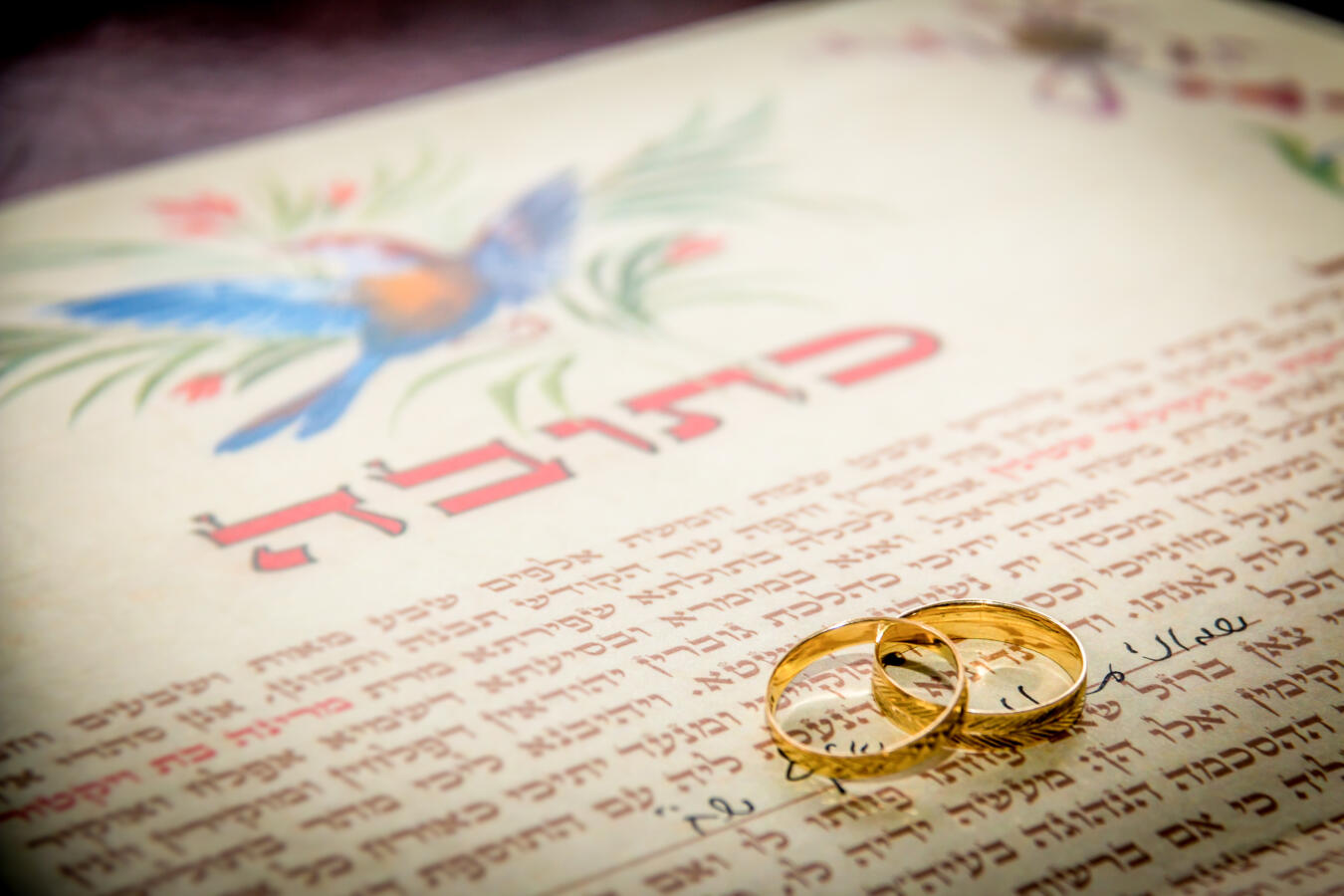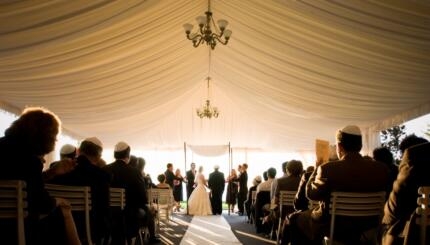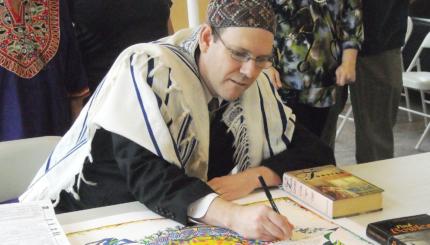The symbols of the Jewish wedding ceremony are familiar to many American Jews, regardless of their level of observance. The chuppah (bridal canopy), ketubah (Jewish marriage contract), simple wedding band(s), and breaking of glass, among other things, distinguish a Jewish wedding from its non-Jewish counterpart. Add to these the presence of both parents in the processional, klezmer or other Jewish music, and lifting the couple high in the air on chairs, and our sense of simcha (festive celebration) becomes even more tangible.
Are you planning a Jewish wedding? Let us help out! Sign up for Breaking the Glass, an email series that will help guide you to the wedding that’s right for you!
Less familiar to many Jews, however, are the many “updates” of traditional Jewish wedding rituals that have become increasingly popular among brides and grooms. An engaged Jewish couple has many options to choose from as they plan their ceremony, some of which would have been unheard of just 25 to 35 years ago.
At the core of these innovations is the advent of feminism, which has had a tremendous influence on Jewish lifecycle rituals. The wedding is no exception. The traditional notion of a groom “acquiring” his bride (in Hebrew, the kinyan) is particularly antithetical to the ideals of more liberal Jews, who champion an egalitarian mindset. As a result, the last generation of Jewish newlyweds has launched a re-visioning of certain symbols and rituals that reflect this contemporary perspective.

Help us keep Jewish knowledge accessible to millions of people around the world.
Your donation to My Jewish Learning fuels endless journeys of Jewish discovery. With your help, My Jewish Learning can continue to provide nonstop opportunities for learning, connection and growth.
While Orthodox and other traditional Jews generally shun innovations in Jewish rituals, some modern wedding customs–such as adding a clause into the or adorning the — are within the bounds of traditional Jewish law and are being adopted by many Orthodox couples as well. Other egalitarian innovations — such as transforming the ketubah into a statement of love and commitment — are not acceptable according to traditional Jewish law and would not be adopted by Orthodox couples.
Ketubah: Legal Document or Statement of Commitment?
A deeper consideration of acquisition is an appropriate place to start our survey of these innovations. The text of the traditional ketubah, which has stayed largely the same for centuries, is entirely legalistic. There is no mention of God, love, or romance. Signed by two witnesses, the contract verifies that the groom has acquired the bride and agrees to provide for her, and includes a lien to be paid by the groom in the case of a divorce. The bride accepts the arrangement.
Since the 1970s, Jewish couples have dealt with these limitations on the woman’s role in a variety of ways. Some maintain the traditional Aramaic ketubah text but add a clause that uses financial incentives to encourage the husband to grant the wife a religious divorce in the event that the marriage ends. These extra words help protect the woman from becoming an agunah (a “chained wife”). This situation results when the husband will not grant the wife a get (a Jewish bill of divorce), thus preventing her from being able to marry again (in accordance with Jewish law).
Other couples also maintain the Aramaic text but choose their own English text that describes the home they want to build together or the nature of the love they share. A number of sample English texts exist on the Internet, for instance. Still other couples do away with the Aramaic entirely. These couples may compose their own ketubot in English and Hebrew in accordance with the values they want to govern their marriage.
Multiple options also exist for those couples who choose not to follow the traditional requirement that witnesses be Jewish men. Some couples ask four witnesses — two men and two women, rather than the traditionally required two men — to sign, while others take a fully egalitarian attitude toward witnesses, asking two women or a woman and a man to sign. Some couples ask all present at the ceremony to sign the ketubah, either under or on all sides of the text.
Today’s ketubot also differ from those of [immediately] past generations in regard to their artistry. Many modern-day couples choose their ketubot from “galleries,” both real and virtual. Some design their own ketubot with treasured symbols, or commission a Jewish artist to do it for them. Far from a piece of paper kept in a drawer for safekeeping, today’s ketubot are typically adorned, framed, and prominently displayed in Jewish homes.
In adding ornamentation to their ketubah, couples today are not so much inventing a new tradition as reviving an old one. Most prominently in the late medieval period in Middle Eastern nations, Jews decorated their ketubot with brilliant illumination.
Most radically, perhaps, some couples have chosen to revise the entire notion of “ketubah” altogether. Instead they engage in a brit ahuvim (covenant of lovers). This agreement allows for each spouse to share in an equal partnership; no suggestion of “acquisition” is made at all. A ceremony of this nature does not use a ketubah or rings in the traditional sense. Instead the couple signs a document describing their commitment to each other. Lesbian, gay, and heterosexual couples have formed britot ahuvim.
Personalizing the Chuppah
The chuppah has taken a variety of forms throughout Jewish history. In the early medieval period, the groom would place a tallit (prayer shawl) or veil over his bride, covering her as a symbol of the marriage’s consummation. But with the use of portable canopies in 16th-century Eastern Europe, the chuppah began to refer more to the tent or structure itself and less to the act of covering the bride.
Since there are no legal requirements specifying the dimensions, shape, or ornamentation of a chuppah, modern-day couples make their own decisions regarding its design, and these too, like the ketubah, reflect personal values and priorities. Some use their synagogues’ chuppot, while others construct their own. Wedding guests often assume a prominent role in chuppah-making in the months prior to the wedding. For instance, a couple might send each of their guests a square of fabric and ask them to create personalized designs on that square. All the squares would be sewn together prior to the wedding to create the chuppah.
Circling Reinterpreted From Egalitarian Perspective
In traditional Jewish weddings, the bride circles the groom three or seven times before she enters the huppah. Though not a part of the liturgy itself, this custom is observed in many communities. The bride’s circle symbolizes her protection of the groom and her shift in commitments: Her top priority is now her husband (while before it was her parents). Until recently, liberal Jews usually chose to omit this ritual from their ceremony since it suggested the bride’s subservience to her groom. Like kinyan, many considered circling antiquated and irrelevant to modern times.
For a good number of couples, this perspective has changed, and circling has made a “reappearance” in some liberal Jewish weddings. One Conservative rabbi in greater Philadelphia has said that about half of the couples he marries choose to include circling in their ceremony. Some brides now view their circles as an active moment in which she defines familial space. Others share the ritual: The bride circles the groom three times, and then the groom circles the bride three times. (This can be adapted for same-sex couples as well.) Finally, the bride and groom circle each other (do-si-do style). These variations reflect “updates” on Jewish tradition that correspond to the couple’s egalitarian values and priorities.
Two Rings, Not One
Jewish tradition calls for the groom to present the bride with an unpierced metal band as a symbol of his promise of marriage to her. When doing so, he must recite the Jewish marriage formula in Hebrew. She must accept it, but is not legally bound to utter any words or do anything other than place it on her finger.
Today, liberal Jews typically choose a more active role for the bride in the ring ceremony. Most commonly, a double-ring ceremony takes place, in which the bride reciprocates the groom’s gesture. She will sometimes repeat the marriage formula as she presents him with a ring, with the gender of the formula adjusted accordingly. Even if the bride does not recite the specific formula, more often than not she makes some active gesture indicating her agreement to marriage.
Many modern couples choose to verbally exchange their vows just before or after the ring ceremony. Although not a part of the traditional Jewish wedding, some couples write their own vows. This practice also is testimony to the large influence of American cultural practice on Jewish wedding rituals.
Breaking the Glass Together
Most of the time, we think of glass breaking as an act the groom does at the end of the wedding ceremony. At that moment all those invited shout “Mazal tov!” [good luck] and get ready for the reception. Now, some couples share this act, with the two partners breaking the glass together.
The Wedding Program
Guests who have attended a number of Jewish weddings in the recent past likely have received at least a few “wedding programs,” which welcome them and explain some of the rituals. As new as it seems, this practice bears a distinct relationship to the traditional custom of handing out benschers (benshen is the Yiddish word for “praying,” and the “benscher” refers to the booklet containing Birkat HaMazon, or Grace after Meals). Today’s wedding programs vary greatly from couple to couple, and serve a variety of purposes. Generally, they are meant to orient the guests to the mood of the simcha.
Much of the information for this article came from Anita Diamant’s 2001 edition of The New Jewish Wedding.





